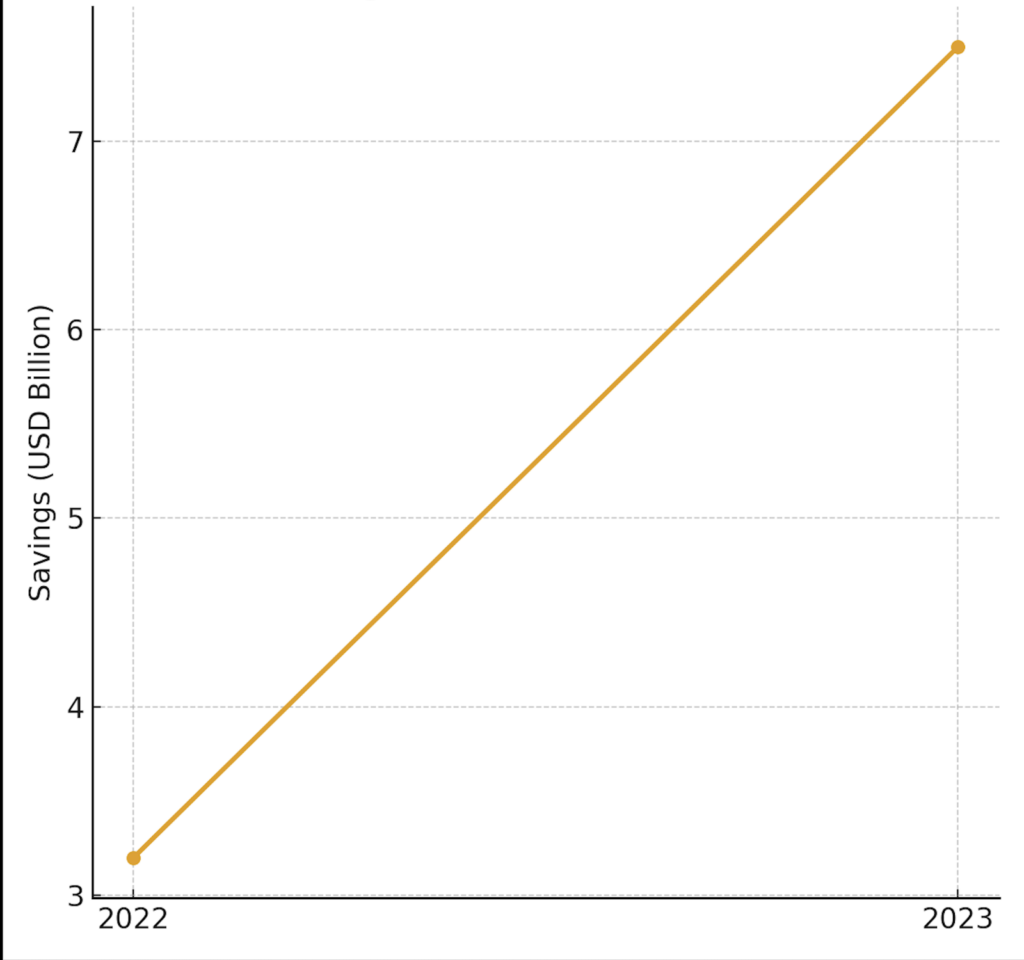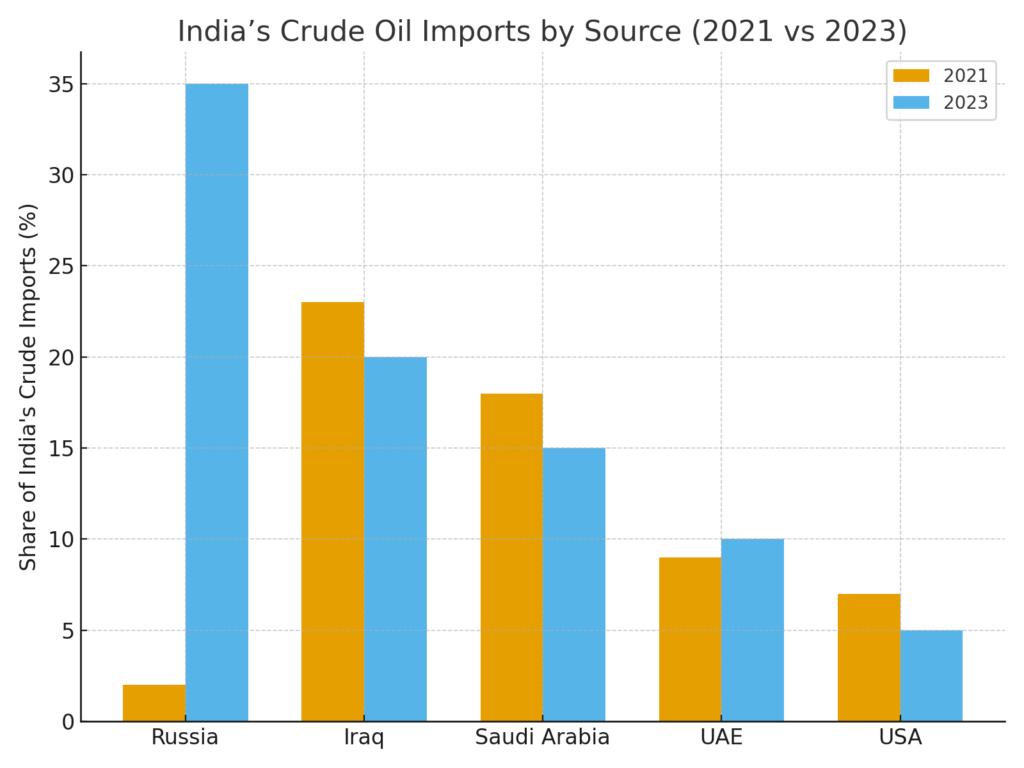
- Russia became India’s top oil supplier by mid-2023, with discounts of $8–$20 per barrel, resulting in annual savings of $7–$ 10 billion for India.
- Discounted Russian oil lowered import costs, kept fuel prices stable, controlled inflation, and strengthened the rupee and forex reserves.
- India’s refineries profited by re-exporting processed Russian crude to Europe and Asia, boosting petroleum exports and government revenue.
- The oil trade with Russia has given India strategic leverage, balancing its ties with Moscow and the West while supporting its long-term energy security.
The global energy landscape has changed significantly since the Russia–Ukraine war broke out in February 2022. The West’s sanctioning of Moscow has forced Russia to move crude oil export sales away from European and Asian markets, especially China and India. India, as the world’s third-largest consumer and importer of crude oil, has strategically seized the opportunity and purchased discounted Russian crude. This allowed India not only to improve its energy security but also to create significant macroeconomic and geopolitical Impacts.
Russia’s Oil Discount: A Strategic Opportunity for India
Western sanctions against Russia, specifically the G7 price cap of $60 per barrel in December 2022, limited Moscow’s capacity to sell crude at global benchmark levels. European demand disappeared, and Russia sold at deep discounts to those willing to bypass Western sanctions. India, historically dependent on Middle Eastern producers such as Iraq and Saudi Arabia, became a major Russian crude purchaser.
Before the Ukraine war, Russia was providing less than 2% of India’s crude imports. By the mid-point of 2023, this jumped to over 40%, making Russia India’s leading oil supplier. The discounts have often ranged between $8 and $20 per barrel compared to Brent crude. For an economy importing nearly 5 million barrels per day, the savings have been substantial. The benefits for India are many.
1. Reducing India’s Import Bill: India imports oil worth over $150 billion each year. So, a small savings on crude prices can result in billions saved. For example, if India imports 1 million barrels per day from Russia and gets a $10 per barrel discount, that is $10 million saved daily, or about $3.6 billion a year. When working with a bigger volume, such as 1.5–2 million barrels per day, those savings could reach over $7–8 billion per year.

2. Strengthening Energy Security: By tapping into Russian crude and decreasing reliance on traditional suppliers, India has reduced its reliance on the Middle East and secured more stable, long-term energy supplies.
3. Cushioning Inflation and Supporting Consumers: Discounted Russian oil means the Indian government has kept home fuel prices steady, while global markets are in flux, which has been a big help in controlling inflation.
4. Boost to India’s Refining Sector: India’s refining industry has arguably benefited the most. Refineries like Reliance Industries and Nayara Energy have converted Russian crude into diesel and jet fuel and exported them to Europe and Asia at prices prevailing in the international market. This has contributed significantly to India’s petroleum exports in FY2023, which accounted for around 15% of total exports.
5. Strengthening the Rupee and Forex Stability: By cutting down its dollar spending and using the rupee and the dirham for part of its trade, India has managed to shield the rupee from falling too sharply in value.
6. Fiscal Savings for the Government: Stable oil prices have allowed the government to avoid increasing subsidies, while increased overall demand has garnered more revenue through excise duties.
7. Geopolitical and Strategic Leverage: India has managed to delicately balance ties with both Moscow and the West by continuing to import Russian crude oil. Although both the U.S. and Europe expressed concern, they accepted India’s position because of India’s relevance in countering China.
8. Encouraging Industrial Competitiveness: Lower energy costs have increased the competitiveness of sectors like steel, cement, fertilisers, and manufacturing.
9. Long-Term Implications for India’s Energy Strategy: Challenges remain despite the gains, like payment risks, sanctions-related problems in shipping and insurance, and balancing the green transition.
India’s Oil Imports in 2022–23
In 2021, Russia supplied less than 1% of India’s oil imports. By June 2023, Russia supplied nearly 45%, overtaking Iraq and Saudi Arabia. India saved an estimated $7–10 billion in 2022–23 due to discounted oil. Indian refiners processed Russian crude into diesel and exported it to Europe, ironically supplying the very countries that sanctioned Russia.

India’s decision to purchase oil from Russia, even while Western countries impose sanctions, has proved to be an astute act of economic diplomacy. The discounted crude has saved on import costs, contained inflation, improved refining margins, supported the rupee and enhanced the country’s fiscal position. More than just economics, such an act has also provided India with greater geopolitical autonomy and enhanced leverage globally.
In many respects, the India-Russia oil trade shows how rising powers can transform global crises into opportunities, building resiliency and value even in the midst of uncertainty.
Daljeet Singh holds a BTech in Computer Science and is currently pursuing an MA in Political Science. His interests range across geopolitics, international relations, and technology. An avid reader and writer, he is passionate about exploring the intersections of these fields. Views expressed are the author’s own.
